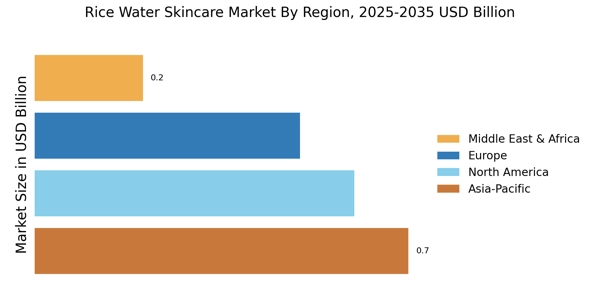Focus on Sustainable Packaging Solutions
Sustainability is becoming a critical consideration for consumers when selecting skincare products, influencing the Rice Water Skincare Market. As environmental concerns grow, brands are increasingly adopting sustainable packaging solutions to appeal to eco-conscious consumers. The use of recyclable materials and minimalistic packaging designs not only reduces environmental impact but also aligns with the values of a significant segment of the market. Research indicates that approximately 70% of consumers are willing to pay a premium for products that utilize sustainable packaging. This trend suggests that the Rice Water Skincare Market could see enhanced consumer loyalty and brand differentiation through the implementation of eco-friendly practices.
E-commerce Expansion and Digital Marketing
The rapid expansion of e-commerce platforms is transforming the retail landscape for the Rice Water Skincare Market. With more consumers turning to online shopping for convenience and variety, brands are leveraging digital marketing strategies to reach a broader audience. The rise of social media influencers and beauty bloggers has further amplified the visibility of rice water skincare products, driving consumer interest and engagement. Recent data indicates that online sales of skincare products have surged, with e-commerce expected to account for over 30% of total skincare sales in the coming years. This shift presents a significant opportunity for the Rice Water Skincare Market to capitalize on digital channels, enhancing brand awareness and accessibility.
Cultural Influence and Traditional Practices
Cultural influences play a significant role in shaping consumer preferences within the Rice Water Skincare Market. Traditionally, rice water has been utilized in various cultures, particularly in Asia, for its skin-enhancing properties. This historical usage lends credibility to the efficacy of rice water, making it a sought-after ingredient in modern skincare products. As consumers increasingly seek authenticity and heritage in their beauty routines, the demand for rice water-infused products is likely to rise. Market analysis suggests that products rooted in traditional practices are experiencing a resurgence, with a notable increase in interest from younger demographics who value cultural authenticity. This trend could potentially drive the growth of the Rice Water Skincare Market as it aligns with the desire for products that tell a story.
Growing Consumer Awareness of Natural Skincare
The increasing consumer awareness regarding the benefits of natural ingredients in skincare products is a pivotal driver for the Rice Water Skincare Market. As consumers become more informed about the potential harmful effects of synthetic chemicals, they are gravitating towards products that feature natural components. Rice water, known for its nourishing properties, is gaining traction as a key ingredient in skincare formulations. This trend is reflected in market data, which indicates a rise in sales of natural skincare products, with the segment projected to grow at a compound annual growth rate of approximately 8% over the next five years. The Rice Water Skincare Market is thus positioned to benefit from this shift towards natural and organic skincare solutions.
Innovative Product Development and Diversification
Innovation in product development is a driving force within the Rice Water Skincare Market. Brands are continuously exploring new formulations and product types that incorporate rice water, such as serums, masks, and cleansers. This diversification caters to a wide range of consumer needs and preferences, enhancing market appeal. Recent trends indicate that multifunctional products, which combine various skincare benefits, are gaining popularity among consumers. The Rice Water Skincare Market is likely to benefit from this trend as brands introduce innovative offerings that highlight the versatility of rice water. This focus on product innovation could potentially lead to increased market share and consumer engagement.


















Leave a Comment